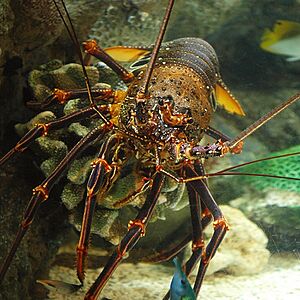Longlegged spiny lobster facts for kids
Quick facts for kids Longlegged spiny lobster |
|
|---|---|
 |
|
| Conservation status | |
| Scientific classification | |
| Genus: |
Panulirus
|
| Species: |
longipes
|
Panulirus longipes, also known as the longlegged spiny lobster, is a type of lobster. It lives in warm, tropical waters. You can find it on shallow rocky and coral reefs in the Indo-Pacific region. This area includes places like Madagascar, Japan, and Australia. Scientists have checked on this lobster. They say it is doing well. It is listed as "least concern" for its conservation status. This means it is not currently in danger of disappearing.
What Does It Look Like?
The longlegged spiny lobster can grow quite large. It can reach up to 30 centimeters (about 12 inches) long. Most adults are usually between 20 to 25 centimeters (8 to 10 inches). Its main body shell, called a carapace, can be up to 10 centimeters (4 inches) long.
This lobster is usually dark brown or bluish-brown. It has many round white spots on its tail section. There are fewer spots on other parts of its body. Its legs have light-colored stripes running along them. Sometimes, there is a single white spot near the tip of its legs.
Where Do They Live?
The longlegged spiny lobster lives in tropical and subtropical parts of the Indo-Pacific. Its home stretches from Madagascar and East Africa. It goes all the way to Malaysia, Japan, and northern Australia. You can also find it in places like the Philippines and Papua New Guinea.
These lobsters live on rocky and coral reefs. They usually stay in shallow water. This is often less than 18 meters (about 60 feet) deep. But sometimes, they can be found much deeper. They have been seen as deep as 122 meters (about 400 feet).
There are two main types, or subspecies, of this lobster. One type, P. l. longipes, lives from East Africa to Indonesia. The other type, P. l. bispinosus, is found from Japan to Australia and many Pacific islands.
Life Cycle and Habits
The longlegged spiny lobster is active at night. This means it is nocturnal. During the day, it hides in cracks in rocks. It also hides under large stones. It eats molluscs, like snails, and other small animals that live on the seabed.
When it feels threatened, this lobster can make sounds. These sounds help it defend itself. Female lobsters carry many tiny eggs. They keep these eggs tucked under their tail for several months.
When the eggs hatch, tiny larvae come out. These larvae float in the ocean as plankton for about ten months. Then, they change into a special young form called puerulus larvae. These young lobsters then settle down on the seabed.
Young lobsters do not live in groups at first. They are usually found in shallower water than the adults. They grow slowly. They reach a carapace length of about 2 centimeters (less than an inch) in about a year and a half. These lobsters usually start to breed when they are about five years old.
Conservation Status
People catch this spiny lobster in many places where it lives. They catch it for food. Most of the fishing is small-scale. Fishermen use lobster pots, spears, and nets to catch them.
We do not have exact numbers for how many lobsters there are. It is possible that too many are being caught in some areas. This is called overfishing. However, this lobster lives in a very large area. It is also common in many parts of its range. Because of this, the International Union for Conservation of Nature says it is of "least concern." This means it is not currently at risk of extinction.



